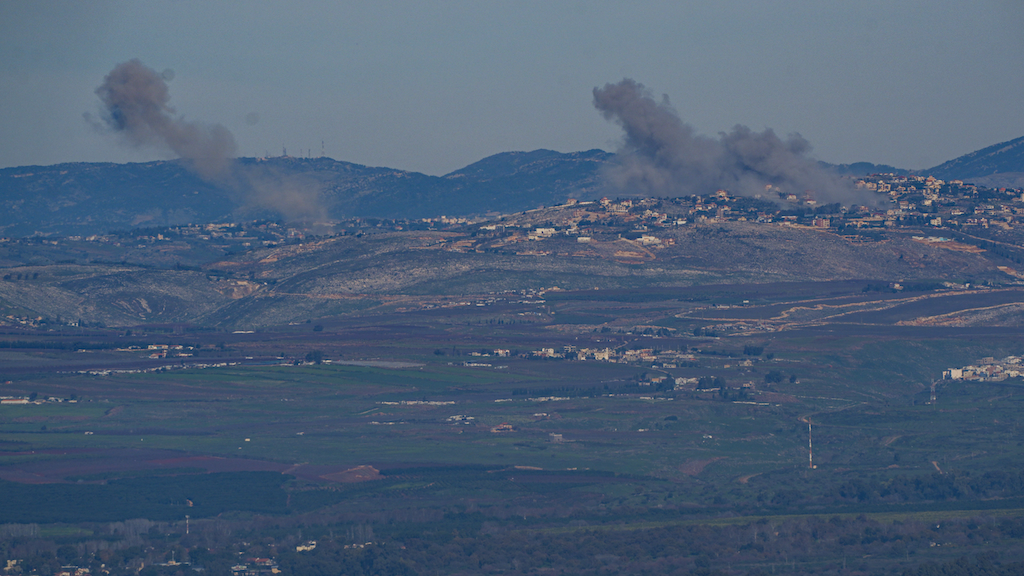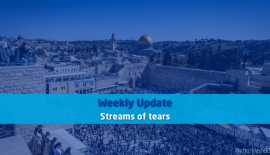Israel and the new six-front War of Independence
At the time of writing this article, it has been more than three months since the Simchat Torah War began, a war the likes of which Israel has never seen, and which has already had major consequences for the country and each of us here personally.
On October 7, 2023, Hamas, aided by Palestinian Islamic Jihad and civilians, not only slaughtered more than 1,200 Israelis but also killed the hope that there would ever be a peaceful solution to the more than century-old conflict with the Palestinian Arabs.
Other consequences are unique in the history of the State of Israel, as we will see.
When I read the first reports of that day on October 7 and saw that hundreds of rockets had been fired into Israel, my first reaction was: here we go again.
In Israel, we had become accustomed to the pop-ups on our smartphones from the code-red alarm system after sixteen years of rocket fire. Still, fifteen minutes later I received the first updates on what was really going on at that moment and realized we were in big trouble.
I watched in amazement as the stream of updates on my smartphone showed that Hamas was invading southern Israel and my first thought was how?? How could this happen??
As someone who has been writing for almost eight years about the so-called multi-front war that Iran was preparing for Israel and was aware of the IDF’s preparations for such a war, this was my first thought.
Through all the documents and information I had received over the years about Iran and the IDF’s operations in what in Israel was called MABAM (Milchama bin haMilchamot), the war between the wars, I had become convinced that the army was excellently prepared for this war.
Because the information provided in the first hours of that Black Shabbat was poor and was often based on eyewitness accounts over the telephone, my question was left hanging in the air and was otherwise not relevant at that moment.
Many in Israel realized that action had to be taken and in my case, this meant setting up a war room from which I could send updates to the live blog on the Christians for Israel website.
For others, this meant collecting the army equipment and a weapon and then rushing southward, or booking a plane ticket on the first plane that would fly to Israel.
I think that after the initial shock, everyone understood that we were in a state of emergency and that action had to be taken. What happened in the days after the full extent of the genocide became clear can safely be called unique in the history of Israel.
The people of Israel spontaneously took over the country with thousands of volunteers leaving everything behind and starting initiatives that would contribute to the survival of Israel and to the care of the victims who survived the massacre since that was the general feeling, Israel was engaged in a second War of Independence.
To a lesser extent, we saw something similar after the suicide bombing of the Park Hotel in Netanyahu on Seder evening, the first day of Passover at the end of March 2002.
Thirty people were killed in that attack while 140 others got injured and it was the timing (the most important evening on the Jewish calendar) that caused many people to take action immediately.
Also then, thousands of IDF reservists came to their bases without Tzaf Shmoneh (mobilization order), and there was also a similar determination to put an end to the wave of suicide bombings but now an even stronger reaction was noticeable.
Expat Israelis returned to Israel to re-enlist in the IDF or to help with the hundreds of private initiatives that had been launched since the genocide took place.
Others left their jobs to help identify those murdered, and the same people who were behind the anti-government protest campaign in the months before 10/7 now began an international campaign to bring home the more than 240 abductees.
In social terms, a revolutionary change also took place. While the various groups in Israeli society were 7/10 diametrically opposed to each other, and some even used the word civil war at the time, now those divisions suddenly seemed to have disappeared and made way for brotherly unity.
Ultra-Orthodox Jews who had always refused to serve in the IDF now signed up in droves to receive emergency training in the use of weapons and wanted to join the two fronts that had already emerged.
Left-wing activists who were always found at pro-Palestinian demonstrations suddenly changed their minds and fought side by side with right-wing religious soldiers in combat units.
A large number of these activists have now been cured of the peace illusions they always harbored and say there is no partner to talk to.
Politically, we saw that politicians who had fought each other day in and day out now formed a war cabinet together and there was an overriding consensus that Israel was fighting for its survival and that Hamas had to be indefinitely defeated.
That consensus still exists, although there is now a difference of opinion about the two goals of the war with Hamas, and this is especially evident over the question of what to do with the 134 hostages held in Gaza.
For those involved in the international campaign to free the hostages, this issue is more important than a victory over Hamas but the vast majority of the Israeli public insists on not stopping the war again and continuing fighting to the end, even if that means losing some of the hostages.
For the first time, it appears that Israel will not give in to foreign pressure to stop the war over the humanitarian problem in Gaza.
A new ceasefire is only beneficial for Hamas, which now has to fear the end of its rule in Gaza, although there is enormous internal pressure on the government of Prime Minister Benjamin Netanyahu to agree to another agreement because of the 134 hostages Hamas is holding.
Then there is Hezbollah in Lebanon, which has been waging a war of attrition against Israel since October 8, and here too, there is consensus that the situation as it existed before 7/10 can no longer be tolerated.
The nearly one hundred thousand evacuees who have been transferred from their homes in the villages and towns along the border with Lebanon to hotels and holiday homes in northern Israel are united in their demand for an end to Hezbollah’s presence along the border. Until that is the case, they will not return home.
I spoke to some of these evacuees, who said they had been told by the government that there was no chance of returning home before Passover at the end of April.
Many of these evacuees have now rented vacant houses or vacation homes and are trying to resume their daily routine in one way or another as compensation measures have been introduced to undo at least some of the financial damage suffered by these families.
The government is now preparing the people for a long war that could last until the year 2025. Whether that happens depends on developments in the war with the Iranian axis of evil.
Israel is in the midst of a six-front war, Defense Minister Yoav gallantly said recently. These six fronts are Gaza, Judea and Samaria, Syria, Yemen and Iraq, where a recently established umbrella organization of Shiite militias called the Islamic Resistance of Iraq is not only launching attacks on US bases (almost 500 since 7/10) but also sporadically attacking Israel with long-range missiles or drones.
As things stand now, Iran is slowly escalating this multi-front war as the Iranian Revolutionary Guards have recently also started carrying out raids on ships in the Indian Ocean and on American bases in Iraq as well as a Mossad base in Iraqi Kurdistan, or so Iran claimed.
The two most dangerous fronts for Israel are Yemen and Lebanon.
In recent weeks the situation on the front with Hezbollah has escalated and Israel now appears to be heading for a major war with Iran’s most important proxy after diplomatic negotiations through US diplomat Amos Hochstein failed. The IDF now appears to be preparing for a major operation expected to begin within weeks.
According to the Israeli think tank INSS, Hezbollah has 200,000 rockets and advanced mortar shells at its disposal. Thousands of Hezbollah’s missiles are equipped with a GPS guidance system and can therefore reach their target accurately.
It is estimated that in the event of a full-scale war, Hezbollah will fire 1,200 to 1,500 rockets per day at Israel.
Since Hezbollah has precise intelligence through espionage about Israel’s vital civil and military infrastructure, it is to be expected that Israel’s economy will come to a virtual standstill and that a very different situation will then exist than is the case now.
At the moment, there is a business-as-usual situation in large parts of Israel, except for the border areas, but Hezbollah’s long-range missiles that can reach all of Israel could bring day-to-day life to a complete standstill.
The second most dangerous front is Yemen, where the Ansar Allah (Houthi) militia continuously attacks civilian shipping. Ansar Allah is helped by advisors from the IRGC and Hezbollah who are stationed in Yemen and the international coalition of naval vessels formed under US leadership appears to have made little impression on the Iranian proxy so far despite escalating attacks on the military infrastructure of the militia.
In the capital Sana’a there are huge mass demonstrations every week in which Israel and the US are cursed. The American army, together with that of England, has now carried out seven attacks on Ansar Allah bases in Yemen so far.
However, the militia appears determined to continue its attacks because this will lead to a complete halt to shipping traffic in the Red Sea, where sixteen percent of the world’s total maritime trade passes every day so this front has the potential to develop into a global conflict.
Israel is therefore in a very difficult position that even dwarfs the situation that occurred in 1967 and 1973 during the Six-Day War and the Yom Kippur War.
The current multi-front war coincides with the loss of the ability to effectively monitor Iran’s nuclear program as the IAEA actually reported on January 19.
Observers in Israel, myself included, fear that Iran will use the current chaos in the Middle East and the obsession with the war in Gaza to move toward a nuclear weapon.
The Islamic Republic now has enough uranium, enriched to 60 percent, which can be upgraded within a few weeks to the 91 percent needed to produce a nuclear warhead.
This is, in short, the state of affairs in Israel and the Middle East, and it will be clear that the Jewish state will be in serious trouble if the war escalates further according to the ‘ring of fire’ plan for the destruction of Israel that Iran drew up years ago.






